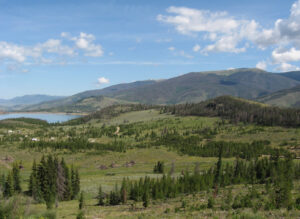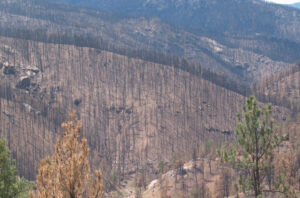After a wildfire in a watershed, water utilities are faced with an expensive recovery process as well as issues like erosion and the entry of sedimentation into reservoirs that can continue for decades after the last ember is extinguished. In this interview, Municipal Water Leader speaks with Christina Burri, who leads Denver Water’s watershed planning efforts. Through programs such as the From Forests to Faucets partnership, Denver Water and its partners have invested $66 million since 2010 in forest health and wildfire risk reduction projects to protect its 2.5‑million-acre water supply watershed.
Municipal Water Leader: Please tell us about your background and how you came to be in your current position.
Christina Burri: I am a watershed scientist at Denver Water. Before joining Denver Water, I worked for the Bureau of Reclamation, and before that, I worked for the State of Ohio on funding for source water protection projects. It was the biggest watershed health funding source in Ohio— $15 million per year, generated from the state revolving fund. I have been with Denver Water for about 6 years, and I am tasked with building the utility’s new watershed planning program. Most of my time is spent on our forest health commitments for wildfire risk reduction in the watershed.
Municipal Water Leader: Please briefly introduce Denver Water.
Christina Burri: Denver Water serves about 1.5 million people in the Denver metro area. We have 12 major reservoirs in our 2.5‑million-acre watershed. Denver Water only owns 2 percent of the watershed land. About 54 percent is national forest, and about 34 percent is privately owned. Healthy forests equal healthy watersheds for Denver Water, which is why we are so committed to improving forest health conditions.
Municipal Water Leader: Are the watersheds all located on the western side of the Continental Divide?
Christina Burri: Denver Water’s collection area covers 4,000 square miles on both sides of the Continental Divide. On average, we capture around 290,000 acre-feet of water from rain and melting snow every year. About 80 percent of Colorado’s precipitation falls on the west side of the Continental Divide, so Front Range communities bring water over from the west slope.
Denver Water has two water collection systems. The North System covers parts of Boulder, Clear Creek, Gilpin, Grand, and Jefferson Counties. Eighty percent of Denver Water’s supply comes from the South System, which captures water from the South Platte and Blue River basins. Water from the South Platte River is stored in a series of reservoirs, and water from the Blue River is stored in Dillon Reservoir and then delivered to the Front Range through the Roberts Tunnel under the Continental Divide.
Municipal Water Leader: How frequent are wildfires in Denver Water’s watershed?
Christina Burri: We have frequent fire starts in the watershed, particularly on the Front Range. The first major fire in the watershed in recent decades was the 1996 Buffalo Creek Fire. It burned about 12,000 acres, which was considered a lot at the time. It was just upstream of the Strontia Springs Reservoir, which 80 percent of our water supply moves through. In 2002, the Hayman Fire burned around 138,000 acres. It occurred in our South System around Cheeseman Reservoir. We’re still recovering from both fires today, even 20 years later; it still looks like a moonscape out there. The Hayman Fire was severe, and recovery just hasn’t occurred as we anticipated. The 2020 wildfire season was also bad for Colorado. That year, we had the 14,000‑acre Williams Fork Fire in our North System. We are still working with partners in Grand County and the U.S. Forest Service (USFS) to recover. These fires show that postfire recovery is a long-term process. We started tracking fire starts last year. It’s important to understand where these fires are beginning and where the high-risk areas in the watershed are.

Municipal Water Leader: Would you explain the main threats that those fires pose to water quality?
Christina Burri: Wildfires affect water utilities like Denver Water in two main ways. The first is certainly water quality. The water that comes into the treatment plant is affected in the near term following a wildfire. Longer term, there is the potential for elevated nutrients and metals. The second effect is runoff and sedimentation in the reservoirs, which is costly to remove. After the Buffalo Creek Fire in 1996 and the Hayman Fire in 2002, Denver Water spent about $28 million on recovery. Of that, $18.5 million was spent dredging Strontia Springs Reservoir to remove sediment and debris. Today, 20 years later, sediment is still entering the reservoir. Wildfires also affect infrastructure, such as our diversion structures, and even our facilities and land. Denver Water owns about 60,000 acres, and we have facilities and caretaker homes on site.
Municipal Water Leader: Does the runoff of nutrients, metals, and other substances pose a potential risk to human health?
Christina Burri: It could, but we’ve been able to manage that at the treatment plant. So far, we haven’t had any water quality effects that we haven’t been able to treat, but it does add an extra cost to the treatment process.
Municipal Water Leader: You mentioned that even 20 years after the Hayman Fire, there are still issues to address. What are those issues?
Christina Burri: When you have a high-intensity fire that burns exceptionally hot, it changes the structure of the soil and makes it more erosive. That generates more sediment and erosion, which affects the watershed and the reservoirs and other water utility facilities. It also sterilizes the seed bank, which impedes recovery and revegetation. Those two things work in combination: The soil structure erodes, and there are no plants to hold it in place.
To address these continuing issues, we’re looking at proactive watershed investments such as riparian plantings. We’re also looking at doing stream restoration work to stabilize some of the sediment on the banks upstream of Strontia Springs Reservoir. Our engineers have calculated that if we can reduce the amount of sediment coming into Strontia Springs by just 5 percent, we’ll see a return on our investment. Making upstream investments in the watershed is cost effective.
Municipal Water Leader: Would you talk more about some of the main mitigation activities you have carried out, particularly for recent fires?

Christina Burri: In our recovery work for the 2020 Williams Fork Fire, we are partnering with the USFS, which owns most of the land that was affected. The Youth Corps is doing a lot of the actual implementation of the best management practices. Initial recovery efforts were focused on trying to save the road that we use to deliver supplies to our onsite caretakers from washing out. After rain events on these burn scars, culverts alongside roads become overloaded, and there is a risk that roads will wash out. We also want to protect the diversion structures underneath the roads. The Youth Corps put in small rolling dips and other structures along the road to help water drain off the road. Hazardous trees also need to be removed. There are many burned trees that could fall and block the road, so we remove them and use the logs as erosion barriers.
Municipal Water Leader: What are some of the longer-term investments you are making in forest health?
Christina Burri: That’s where our biggest commitment is—wildfire risk reduction in critical watersheds. Since 2010, Denver Water has committed over $33 million to a partnership with the USFS, the Colorado State Forest Service, and the Natural Resources Conservation Service called From Forests to Faucets. This partnership was motivated by the need to understand the cost of recovery after these fires. We realized how cost effective it is to be proactive in reducing wildfire risk. The partners matched our investment dollar for dollar, and a total of $66 million has been invested in forest health and wildfire risk reduction projects in Denver Water’s critical water supply watersheds.
A lot of the risk reduction work is focused on thinning or removing hazardous fuels in the forest, an intervention that also helps protect trees from insects and disease. The work restores forest conditions to promote trees of different ages, classes, and species and to create openings that allow for the suppression of fire. The end result mimics how these forests typically looked in the past. It’s been a successful partnership. We’ve seen, for example, that a fuel break we made in Summit County saved approximately $1 billion worth of infrastructure and homes. Investments in the forests are a smart business decision for water utilities like Denver Water.
Municipal Water Leader: Do you do any work in partnership with local or private landowners?
Christina Burri: The Colorado State Forest Service and the Natural Resources Conservation Service work with private landowners in the watershed. Aided by state and federal funding, Denver Water provides money to private landowners to help them implement forest health projects through our partners.
Municipal Water Leader: What effects are you seeing from your efforts?

Christina Burri: We’re seeing a lot of success stories. The State Forest Service did hazardous fuels reduction on Denver Water lands before the Hayman Fire occurred. That work saved our facilities. In the 2018 Buffalo Mountain Fire, the fuel break that I mentioned saved $1 billion worth of homes and infrastructure. When fire starts occurred in the South Platte watershed in 2018 and 2020, wildfire responders and local fire protection districts had quick and safe access to the sites thanks to forest treatments done through the From Forests to Faucets initiative. As a result, they were able to suppress fires that could have grown out of control.
Municipal Water Leader: In the future, what results would you like to see from these various forest health initiatives?
Christina Burri: I think a lot of people understand the benefits, but I would like to see more of these success stories showcased. We recently did a study through the Colorado Forest Restoration Institute that showed a return on investment of upward of $240 million for Denver Water from this partnership. Another consideration is the maintenance of these treatments. It is important that the investment is maintained. We want to keep working with our partners, not necessarily on new treatments but on maintaining our investments and ensuring that they’re effective into the future. With climate change, the risk of large and costly wildfires is only going to grow, so these types of investments are critical for municipal water utilities in Colorado and around the country.
Christina Burri is a watershed scientist at Denver Water. She can be contacted at christina.burri@denverwater.org.

